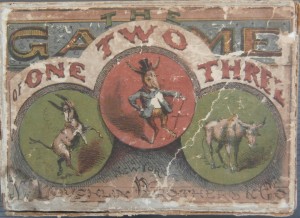 The antique games by Mcloughlin Bros. are cherished collectibles of mine. They are loved for their images and I appreciate their simple styles of game play found in many of them. The 1870’s game of One, Two, Three is one of the early games I have and it holds certain elements that I find amusing when playing the game today.
The antique games by Mcloughlin Bros. are cherished collectibles of mine. They are loved for their images and I appreciate their simple styles of game play found in many of them. The 1870’s game of One, Two, Three is one of the early games I have and it holds certain elements that I find amusing when playing the game today.
The game consists of 45 cards (although the directions state 48), and counters are used during the game. The purpose of these counters is one of the things I find fun about the game. While playing One, Two, Three, counters are given or gained by a player (explained below). According to the directions, whoever has the most counters at the end of game receives a very special privilege; he may ask each player any one question of his choice, and all players are bound to answer honestly.
It is these unique additions to games of the past that are amusing to me. The above is similar in nature to another early game by Mcloughlin Bros. In the 1860’s game of Cock Robin, the winner is the player who places the Thrush card as the last. However, the following rhyme preceding the play tells what the player must do in order to be considered the winner of the game:
“And now Mr. Thrush,
Come out of your bush,
And sing us a song-
Or give us a riddle;
And we’ll grant you the fame
Of winning the game.”
These cute, whimsical rules make me smile. I can imagine in the past they certainly made players smile as well.
To play One, Two, Three, all cards are dealt to players. The counters are equally divided up amongst the players too.
The cards are in sets of three consisting of certain themes. The player who goes first plays a card by placing it in front of him and by reading what it says. The person next to him plays a match to the set, if possible. If he hasn’t a match, he pays a counter to the player who led the card, and the turn passes. The player who plays the ‘third’ card of the set takes the trick, but not before saying a little verse. Depending on the theme, he chooses an adjective, like ugly, silly, smart, etc, for the set, and says as an example for the set of Grasshoppers (shown below):
“One, Two, Three,
Lovely Grasshoppers for me!” (or One, Two, Three; Green, Silly, Grasshoppers for me).
I can see how some players would get creative and provide some humorous verses for all players to laugh at.
The game continues in this manner. If a player holds all three cards, he begins with the first, lets the game go round once to collect counters, and then plays his two cards and takes the trick. Tricks count as one, and twenty win the game. Then at the end of the game, the counters are tallied, and the questions begin!
Below are a few more examples of the small cards in the game:
Now and then I will get out the game of One, Two, Three and play with family or friends. It is just fun to remember and play games of the past. What was fun then, can still be fun today. And it is a good way to ask your kids some questions of which they must answer!

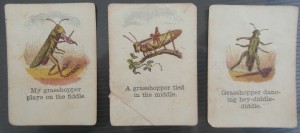
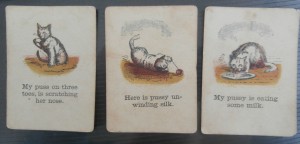
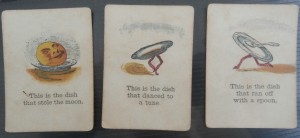
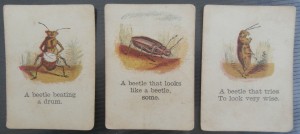
Hello Jenny!
You have done some great work for us all in this web site. THANK YOU!
What I want to know is how I can get the directions for game play for this and other games from this era. I would like to create some similar games for a character in a series I am doing.
I’m thinking of changing the character from working in a Chicago book publisher around 1900 to a Chicago game publisher and have her play the games in the office with co-workers and then the games somehow become part of the adventure. But I would need to know more about the games.
Is there a source that I could access to get this information. I am not a game collector and do not have access to these old games.
Thank you for your help.